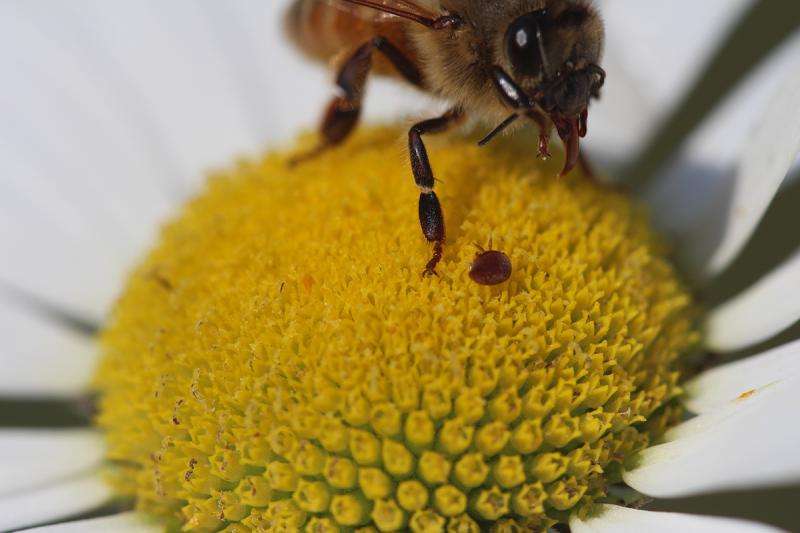Devastating mites jump nimbly from flowers to honeybees

Mites that infest honeybees may be blind with tiny brains, but make no mistake: When a bee sidles up next to them, they are surprisingly quick-footed.
A study, published Dec. 12 in PLOS One, describes for the first time – and documents with video footage – how Varroa mites can nimbly jump from flowers onto bees.
The finding is important because Varroa mites are linked with massive honeybee colony deaths, as they infest nursery cells in honeybee nests and feed on developing bees while also transferring deadly viruses.
The mites are known to readily spread through both managed and wild colonies. In managed colonies, Varroa mites are thought to spread by riding on bees when they rob weak colonies or drift between hives. But widely spaced wild colonies also suffer from mite infestations, even though wild bees rarely venture into other hives. It was suspected that mites could attach themselves to bees when they visit flowers, though this means of transmission has been rarely studied.
"No one has ever shown that bees flying naturally and freely, arriving at flowers and then leaving as they wished, presented a large enough opportunity for Varroa mites to make these jumps," said David Peck, the study's first author and a graduate student in the lab of senior author Thomas Seeley, the Horace White Professor in Biology. Michael Smith, a graduate student in Seeley's lab, is a co-author.
To test whether mites could travel from flowers to bees, the researchers took colonies of honeybees to the Adirondack mountains in upstate New York, where there are very few wildflowers, so the bees' foraging could be controlled. They placed mites on feeders of sugar water and on potted flowers and observed the mites detect bees and deftly navigate their way onto the bees' backs.
"A noteworthy result that we didn't originally expect was that once the mites get onto the bees, they show some pretty sophisticated behaviors to avoid getting groomed off," Peck said. They quickly climbed onto the top of a leg or onto the very center of a bee's back, where the bee could not reach. Eventually, when mites reach a hive, they reproduce in nursery cells in honeybee nests and feed on larval bees.
The findings offer evidence of another mode of transmission of mites to bees, which is important for better understanding the disease risks Varroa mites present and for preventing colony deaths.
But the results also raise concern about shipping cut flowers and spreading Varroa mites to areas where they do not exist, such as Australia.
"If a mite could jump from a flower onto a bee that tried to visit one of these flowers at an open-air flower market, the result could be disastrous," Peck said, adding that stricter safeguards for shipping flowers should be considered. These could include spraying flowers, refrigeration or limiting shipments to flowers raised in secure greenhouses.
Next steps for this research will be to better understand mite behaviors on flowers, such as how often and under what circumstances they end up on flowers.
More information: David T. Peck et al. Varroa destructor Mites Can Nimbly Climb from Flowers onto Foraging Honey Bees, PLOS ONE (2016). DOI: 10.1371/journal.pone.0167798
Journal information: PLoS ONE
Provided by Cornell University


















